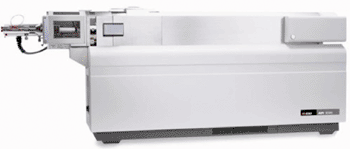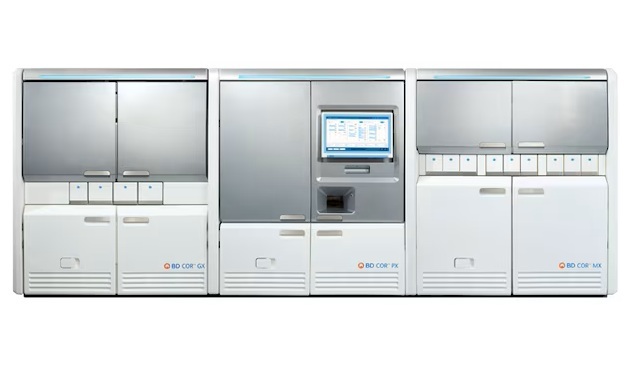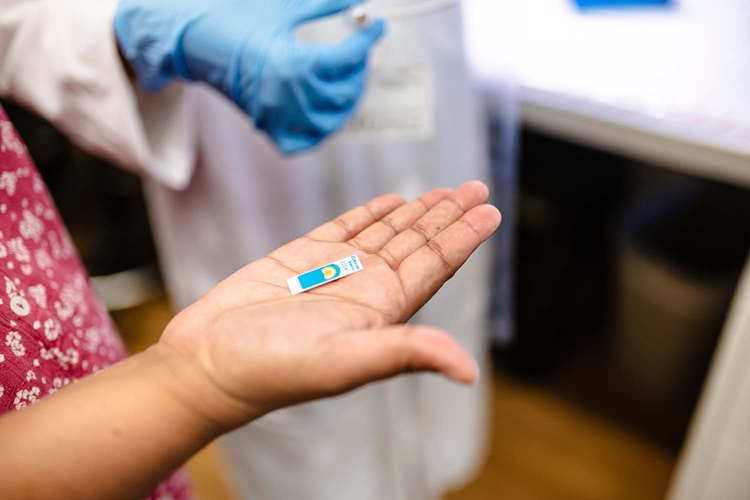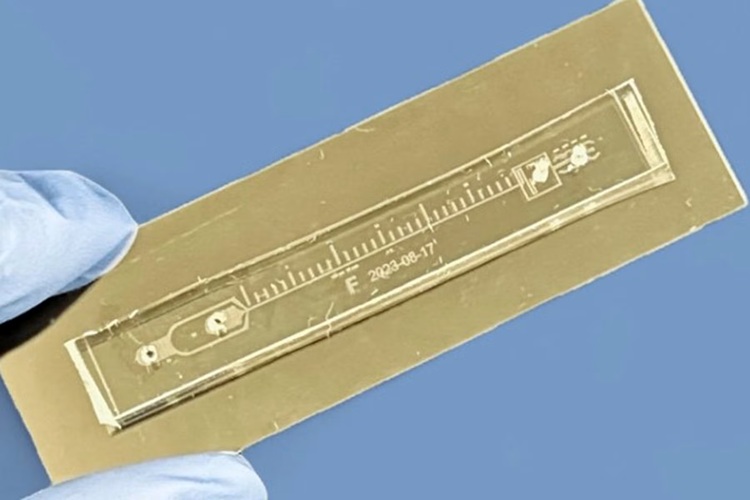Blood Test Determines Reduced and Oxidized Glutathione
|
By LabMedica International staff writers Posted on 31 Jul 2013 |

Image: API 3000 triple-quadrupole mass spectrometer (Photo courtesy of Applied Biosystems).
Diminished levels of glutathione (γ-glutamylcysteinylglycine, GSH) and the ratio of GSH to glutathione disulfide (GSSG) can serve as important indicators of oxidative stress and disease risk.
A simple and sensitive liquid chromatography-tandem mass spectrometry (LC–MS/MS) method for measuring whole blood GSH and GSSG has been developed and can easily be implemented in clinical laboratories.
Scientists at Stanford University School of Medicine (CA, USA) developed an approach that minimizes preanalytical variability through a one-step procedure of deproteinization and derivatization that prevents artifactual oxidation of GSH, and is easily adapted to the clinical setting without requiring excessive constraints on sample handling or storage. The team used anonymous, residual blood samples from 59 healthy individuals, 31 males, and 28 females, with an age range 1 to 87 years, with a mean of 25 years.
Compounds were separated by liquid chromatography using a Hypercarb column (Thermo Scientific; Waltham, MA, USA) at room temperature. The GSH and GSSG ions and fragments were detected using the API 3000 triple-quadrupole mass spectrometer (Perkin-Elmer; Waltham, MA, USA). The final concentrations of GSH and GSSG were expressed in units of μmol/L of whole blood.
The lower limits of detection (LLOD) were 0.4 μM for GSH and 0.1 μM for GSSG and the lower limits of quantitation (LLOQ) were 1.5 μM for GSH and 0.1 μM for GSSG. There was excellent linearity for both GSH and GSSG over the ranges of physiologic normal, with inter- and intra-assay coefficient of variation of 3.1% to 4.3% and accuracy between 95% and 101%. Derivatized samples are stable for at least three years when stored at -80 °C and underivatized samples for at least 24 hours at either 4 °C or room temperature. As a group, the mean concentration ± standard deviation for GSH was 900 ± 140 μM, GSSG 1.17 ± 0.43 μM, and GSH/GSSG ratio was 880 ± 370.
The authors concluded that their LC–MS/MS method minimizes preanalytic variability through a one-step procedure of deproteinization and derivatization, and chromatographic conditions that eliminate ion suppression and increase precision and sensitivity. Additional advantages included the small sample requirement, simple and rapid preanalytical processing, and wide automation possibilities, which makes this method ideal for routine and large-scale clinical testing. The study was published on June 15, 2013, in the Journal of Chromatography B.
Related Links:
Stanford University School of Medicine
Thermo Scientific
Perkin-Elmer
A simple and sensitive liquid chromatography-tandem mass spectrometry (LC–MS/MS) method for measuring whole blood GSH and GSSG has been developed and can easily be implemented in clinical laboratories.
Scientists at Stanford University School of Medicine (CA, USA) developed an approach that minimizes preanalytical variability through a one-step procedure of deproteinization and derivatization that prevents artifactual oxidation of GSH, and is easily adapted to the clinical setting without requiring excessive constraints on sample handling or storage. The team used anonymous, residual blood samples from 59 healthy individuals, 31 males, and 28 females, with an age range 1 to 87 years, with a mean of 25 years.
Compounds were separated by liquid chromatography using a Hypercarb column (Thermo Scientific; Waltham, MA, USA) at room temperature. The GSH and GSSG ions and fragments were detected using the API 3000 triple-quadrupole mass spectrometer (Perkin-Elmer; Waltham, MA, USA). The final concentrations of GSH and GSSG were expressed in units of μmol/L of whole blood.
The lower limits of detection (LLOD) were 0.4 μM for GSH and 0.1 μM for GSSG and the lower limits of quantitation (LLOQ) were 1.5 μM for GSH and 0.1 μM for GSSG. There was excellent linearity for both GSH and GSSG over the ranges of physiologic normal, with inter- and intra-assay coefficient of variation of 3.1% to 4.3% and accuracy between 95% and 101%. Derivatized samples are stable for at least three years when stored at -80 °C and underivatized samples for at least 24 hours at either 4 °C or room temperature. As a group, the mean concentration ± standard deviation for GSH was 900 ± 140 μM, GSSG 1.17 ± 0.43 μM, and GSH/GSSG ratio was 880 ± 370.
The authors concluded that their LC–MS/MS method minimizes preanalytic variability through a one-step procedure of deproteinization and derivatization, and chromatographic conditions that eliminate ion suppression and increase precision and sensitivity. Additional advantages included the small sample requirement, simple and rapid preanalytical processing, and wide automation possibilities, which makes this method ideal for routine and large-scale clinical testing. The study was published on June 15, 2013, in the Journal of Chromatography B.
Related Links:
Stanford University School of Medicine
Thermo Scientific
Perkin-Elmer
Latest Clinical Chem. News
- Chemical Imaging Probe Could Track and Treat Prostate Cancer
- Mismatch Between Two Common Kidney Function Tests Indicates Serious Health Problems
- VOCs Show Promise for Early Multi-Cancer Detection
- Portable Raman Spectroscopy Offers Cost-Effective Kidney Disease Diagnosis at POC
- Gold Nanoparticles to Improve Accuracy of Ovarian Cancer Diagnosis
- Simultaneous Cell Isolation Technology Improves Cancer Diagnostic Accuracy
- Simple Non-Invasive Hair-Based Test Could Speed ALS Diagnosis
- Paper Strip Saliva Test Detects Elevated Uric Acid Levels Without Blood Draws
- Prostate Cancer Markers Based on Chemical Make-Up of Calcifications to Speed Up Detection
- Breath Test Could Help Detect Blood Cancers
- ML-Powered Gas Sensors to Detect Pathogens and AMR at POC
- Saliva-Based Cancer Detection Technology Eliminates Need for Complex Sample Preparation
- Skin Swabs Could Detect Parkinson’s Years Before Symptoms Appear
- New Clinical Chemistry Analyzer Designed to Meet Growing Demands of Modern Labs

- New Reference Measurement Procedure Standardizes Nucleic Acid Amplification Test Results
- Pen-Like Tool Quickly and Non-Invasively Detects Opioids from Skin
Channels
Molecular Diagnostics
view channel
Urine Test Detects Inherited Neuropathy Missed by Genetic Screening
Sorbitol dehydrogenase (SORD)-related neuropathy is one of the most common inherited nerve disorders, yet diagnosis often lags because current genetic screens frequently miss the causal gene.... Read more
Genomic Test Predicts Risk of SCC Metastasis
Managing squamous cell carcinoma (SCC) of the skin in patients with one or more risk factors is a significant clinical challenge, especially as SCC-related deaths are now estimated to exceed those from melanoma.... Read moreHematology
view channel
Platelet Activity Blood Test in Middle Age Could Identify Early Alzheimer’s Risk
Early detection of Alzheimer’s disease remains one of the biggest unmet needs in neurology, particularly because the biological changes underlying the disorder begin decades before memory symptoms appear.... Read more
Microvesicles Measurement Could Detect Vascular Injury in Sickle Cell Disease Patients
Assessing disease severity in sickle cell disease (SCD) remains challenging, especially when trying to predict hemolysis, vascular injury, and risk of complications such as vaso-occlusive crises.... Read more
ADLM’s New Coagulation Testing Guidance to Improve Care for Patients on Blood Thinners
Direct oral anticoagulants (DOACs) are one of the most common types of blood thinners. Patients take them to prevent a host of complications that could arise from blood clotting, including stroke, deep... Read moreImmunology
view channel
Chip Captures Cancer Cells from Blood to Help Select Right Breast Cancer Treatment
Ductal carcinoma in situ (DCIS) accounts for about a quarter of all breast cancer cases and generally carries a good prognosis. This non-invasive form of the disease may or may not become life-threatening.... Read more
Blood-Based Liquid Biopsy Model Analyzes Immunotherapy Effectiveness
Immunotherapy has revolutionized cancer care by harnessing the immune system to fight tumors, yet predicting who will benefit remains a major challenge. Many patients undergo costly and taxing treatment... Read moreMicrobiology
view channel
Blood-Based Molecular Signatures to Enable Rapid EPTB Diagnosis
Extrapulmonary tuberculosis (EPTB) remains difficult to diagnose and treat because it spreads beyond the lungs and lacks easily accessible biomarkers. Despite TB infecting 10 million people yearly, the... Read more
15-Minute Blood Test Diagnoses Life-Threatening Infections in Children
Distinguishing minor childhood illnesses from potentially life-threatening infections such as sepsis or meningitis remains a major challenge in emergency care. Traditional tests can take hours, leaving... Read more
High-Throughput Enteric Panels Detect Multiple GI Bacterial Infections from Single Stool Swab Sample
Gastrointestinal (GI) infections are among the most common causes of illness worldwide, leading to over 1.7 million deaths annually and placing a heavy burden on healthcare systems. Conventional diagnostic... Read morePathology
view channel
Blood Test and Sputum Analysis Predict Acute COPD Exacerbation
Chronic obstructive pulmonary disease (COPD) remains a major contributor to global illness, largely driven by cigarette smoking and marked by irreversible lung damage. Acute exacerbations can accelerate... Read more
AI Tool to Transform Skin Cancer Detection with Near-Perfect Accuracy
Melanoma continues to be one of the most difficult skin cancers to diagnose because it often resembles harmless moles or benign lesions. Traditional AI tools depend heavily on dermoscopic images alone,... Read more
Unique Immune Signatures Distinguish Rare Autoimmune Condition from Multiple Sclerosis
Myelin oligodendrocyte glycoprotein antibody–associated disease (MOGAD) is a rare autoimmune disorder in which the immune system attacks the myelin sheath in the central nervous system. Although symptoms... Read moreTechnology
view channel
AI Saliva Sensor Enables Early Detection of Head and Neck Cancer
Early detection of head and neck cancer remains difficult because the disease produces few or no symptoms in its earliest stages, and lesions often lie deep within the head or neck, where biopsy or endoscopy... Read more
AI-Powered Biosensor Technology to Enable Breath Test for Lung Cancer Detection
Detecting lung cancer early remains one of the biggest challenges in oncology, largely because current tools are invasive, expensive, or unable to identify the disease in its earliest phases.... Read moreIndustry
view channel
Abbott Acquires Cancer-Screening Company Exact Sciences
Abbott (Abbott Park, IL, USA) has entered into a definitive agreement to acquire Exact Sciences (Madison, WI, USA), enabling it to enter and lead in fast-growing cancer diagnostics segments.... Read more










 assay.jpg)












